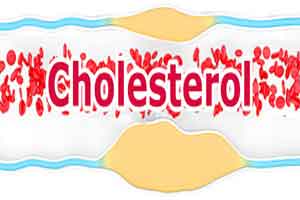- Home
- Editorial
- News
- Practice Guidelines
- Anesthesiology Guidelines
- Cancer Guidelines
- Cardiac Sciences Guidelines
- Critical Care Guidelines
- Dentistry Guidelines
- Dermatology Guidelines
- Diabetes and Endo Guidelines
- Diagnostics Guidelines
- ENT Guidelines
- Featured Practice Guidelines
- Gastroenterology Guidelines
- Geriatrics Guidelines
- Medicine Guidelines
- Nephrology Guidelines
- Neurosciences Guidelines
- Obs and Gynae Guidelines
- Ophthalmology Guidelines
- Orthopaedics Guidelines
- Paediatrics Guidelines
- Psychiatry Guidelines
- Pulmonology Guidelines
- Radiology Guidelines
- Surgery Guidelines
- Urology Guidelines
Statin side effects are strongest predictor of failure to meet cholesterol targets

Statin side effects are the strongest predictor of failure to meet low-density lipoprotein (LDL) cholesterol targets, according to research published in the European Journal of Preventive Cardiology. Other predictors were statin non-adherence and use of weaker statins.
"The beneficial effect of reducing LDL cholesterol on slowing the progression of coronary heart disease is overwhelmingly documented today in epidemiologic and randomised controlled studies," said lead author Dr John Munkhaugen, a cardiology trainee and post-doctoral researcher at Drammen Hospital, Norway.
"European guidelines2 recommend a blood LDL cholesterol goal of less than 1.8 mmol/l but just one in five cardiac patients taking lipid-lowering drugs achieve this,"3 he added.
The NORwegian COR (NOR-COR) prevention project originates from the Department of Medicine at Drammen Hospital and is a collaboration between Drammen and Vestfold hospitals, and the Department of Behavioural Sciences in Medicine and Institute of Clinical Medicine, University of Oslo. It is investigating why patients fail to control risk factors including lipids and blood pressure after they have a cardiovascular event. This analysis examined the reasons why cardiac patients do not achieve the LDL cholesterol target.
The study included 1,095 patients hospitalised with a first or recurrent coronary event or treatment (heart attack, coronary artery bypass graft, or coronary stent) who were identified from medical records at two Norwegian hospitals (Drammen and Vestfold). Sociodemographic, medical and psychosocial information was collected from medical records, an interdisciplinary self-report questionnaire, clinical examinations, and blood samples while patients were in hospital and at follow-up after two to 36 months.
The impact of potential barriers on achieving the LDL cholesterol target was calculated with LDL as a dichotomous (above or below 1.8 mmol/l) and continuous variable.
The researchers found that 57% of patients were not meeting the LDL target of 1.8 mmol/l at follow-up. Statin specific side effects (mainly muscle complaints), low statin adherence, and moderate- or low-intensity statin therapy were the main reasons for failing to meet the target.
Patients with side effects were more than three times more likely to miss the cholesterol target than those without side effects. Those who did not take their statins were three times more likely to miss the target than patients who did take them. Patients prescribed moderate- or low-intensity statins were 62% more likely to miss the target than those prescribed high-intensity statins.
"We found the same three reasons for not meeting the target when LDL was analysed as a dichotomous or continous variable which confirms the strength of the associations," said Dr Munkhaugen. "Surprisingly, low socioeconomic status and psychosocial factors did not predict failure to control LDL cholesterol."
"The findings show that the focus for interventions to improve LDL cholesterol control are statin side effects, and adherence to and prescription of sufficiently potent statins," he continued.
Dr Munkhaugen said more research was needed on why side effects of statins had such a big effect on meeting cholesterol goals. "Patients who experience side effects are probably more likely to reduce or terminate statin use, or their doctor may prescribe a weaker drug or take them off statins altogether," he said. "Individual variations in how the body reacts to and uses the drug may also play a role."
The links between non-adherence and intensity of statin therapy on LDL cholesterol are likely explained by the pharmacological effects of the drug. "Not taking the prescribed amount of statins or being prescribed a weaker statin means there is less drug in the body to act and lower LDL," said Dr Munkhaugen.
"The reasons for statin non-adherence are a complex interaction between factors related to the patient and the healthcare system," he added. "Interventions aiming to improve statin adherence have been a priority in recent years, but the success has been modest and short-lived."
The study found that the use of high-intensity statins was significantly more frequent in patients who achieved the cholesterol target. But Dr Munkhaugen said: "The relationship with adherence and side effects needs to be clarified before advice can be given about the potency of statins that should be prescribed. Our findings point to the need for more research on ways to ensure adherence and prescription of sufficiently potent statins, while at the same time addressing side effects."
You can read the full Article by clicking on the link :
John Munkhaugen, Elise Sverre, Jan E Otterstad, Kari Peersen, Erik Gjertsen, Joep Perk, Lars Gullestad, Torbjørn Moum, Toril Dammen, Einar Husebye. Medical and psychosocial factors and unfavourable low-density lipoprotein cholesterol control in coronary patients. European Journal of Preventive Cardiology, 2017; 204748731769313 DOI: 10.1177/2047487317693134

Disclaimer: This site is primarily intended for healthcare professionals. Any content/information on this website does not replace the advice of medical and/or health professionals and should not be construed as medical/diagnostic advice/endorsement or prescription. Use of this site is subject to our terms of use, privacy policy, advertisement policy. © 2020 Minerva Medical Treatment Pvt Ltd